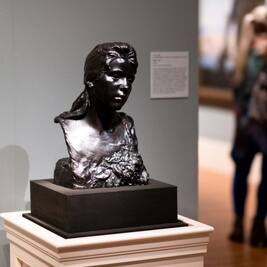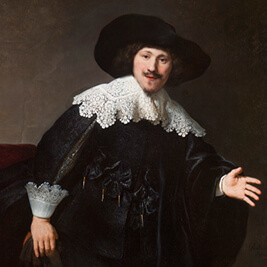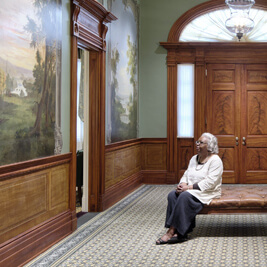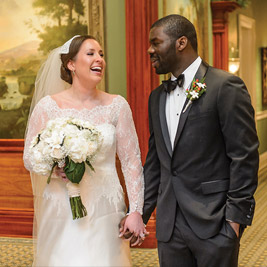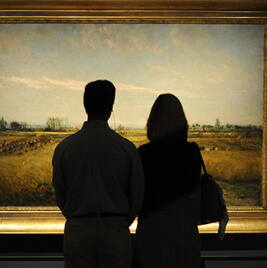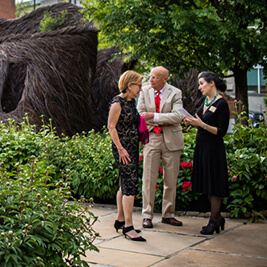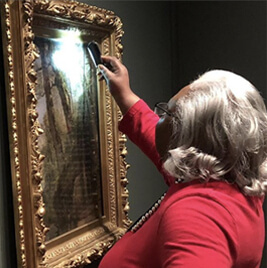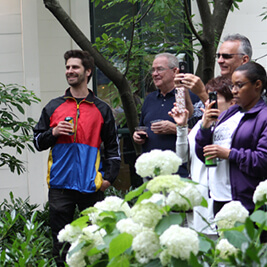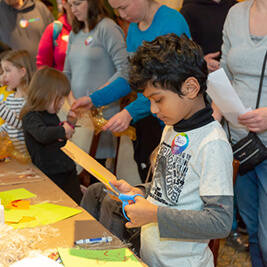- Do + See
- Dine + Host
- Give + Join
- Educate + Learn
Highlights from the Taft Collection | Fall 2020
Anton Mauve, Changing Pasture
Under a cloudy sky, a shepherd leads his flock across a windswept heath. The man holds a shepherd’s hook, and a dog trots near his side. The sheep move toward the horizon in a single mass that Anton Mauve painted using loose brushstrokes, adding details to suggest a few ears and tails. For much of his life, Mauve was inspired by rural life. More than twenty years before painting Changing Pasture, he described a similar scene in the Dutch countryside: “That shepherd came by again with his sheep. I can still hear the jingling and pattering as if it were beautiful music by Beethoven.”
TAKE A CLOSER LOOK
Mauve uses little dabs of brown paint to split the road into three different paths as it nears the horizon. Which path do you think the flock will follow? Why?
Attributed to the Master of the Triumph of the Moon at Marcigny, possibly Pietro da Castel (Durante), Dish with Apollo and the Muse
A wide border of scrolling leaves and bearded masks in rich hues of orange, yellow, and blue frame this dish’s central scene. Beneath a canopy of lush trees, a seated male figure plays the lira da braccio, a stringed musical instrument. He is surrounded by six women enveloped in voluminous robes. Snow-capped mountains and a flowing river appear in the distance. An engraving made after a design for a fresco by Raphael (1483–1520) likely served as the inspiration for this composition. The fresco shows Apollo seated on Mount Parnassus, surrounded by the Muses—goddesses who inspired creativity in the arts and sciences.
TAKE A CLOSER LOOK
Imagine sitting under these trees when inspiration strikes! Sometimes the motivation to create can come from your environment, from deep within yourself, or from other people. What do you enjoy creating? Where do you look for inspiration?
Possibly Henri Toutin, goldsmith and enameler, and Nicolas Bernard, watchmaker, Watch with Rebecca and Eliezer at the Well
A young woman, her graceful figure draped in vivid blue and red fabric, gazes over her right shoulder toward an older, bearded man. Painted by an accomplished artisan, the scene on this French watch case depicts the biblical story of Rebecca and Eliezer. According to the book of Genesis, Abraham sent his servant Eliezer to Mesopotamia to find a wife for his son Isaac. Upon reaching the city of Nahor, Eliezer stopped at a well. There, he met Rebecca, who offered him and his camels a drink of water. Eliezer saw her act of kindness as a sign from God, sealing her future as Isaac’s bride.
TAKE A CLOSER LOOK
Telling a story through an image can be challenging, especially when the composition must be small! How does the artist use the details in the foreground, middle ground, and background to depict the story of Eliezer and Rebecca?
China, Qing dynasty (1644–1911), Kangxi reign (1662–1722), Pair of Guardian Lions
On the right, a male lion places one paw on a ball, while at left, a tiny yellow cub clambers onto a lioness’s front leg. Their bulging eyes, which slide in and out of their sockets, demonstrate heightened watchfulness. In China, pairs of sculpted or carved lions, placed on either side of a doorway, symbolically protect the entrances to temples, palaces, businesses, and residences, deterring malevolent forces from entering. This tradition originated in Buddhism. According to legend, Buddha’s two lion companions once waited motionless at the entrance of a temple for him to return from within.
TAKE A CLOSER LOOK
At first glance, these lions look like they are poised and ready for action. When you look closely at the details, how do these lions appear to you? Ferocious? Playful? What clues make you think so?

